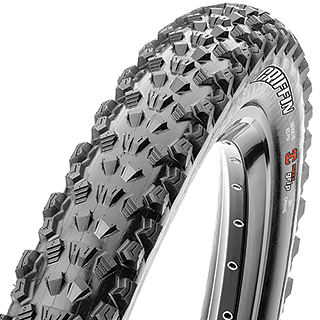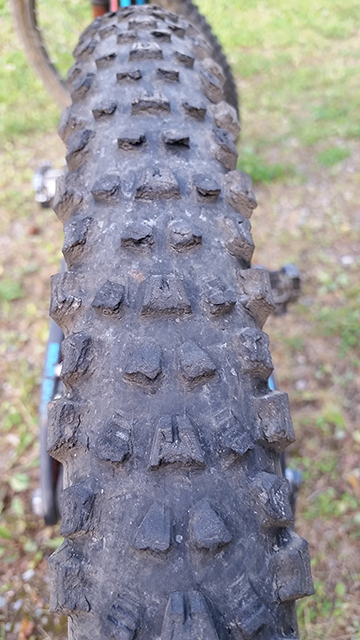
Maxxis Griffin
Stated Width: 27.5” x 2.4”
Measured Dimensions (on a 28mm internal width rim)
Knob width: 63 mm (2.48”)
Casing width: 59.5 mm (2.34”)
DH Casing, 3C Maxx Grip
Measured Weight: 1163 grams
Mounted to: Devinci Wilson
Intended Use: Hardpack DH performance
MSRP: $88
Reviewer: 5’9”, 155 lbs
Locations: Whitefish, MT; Fernie, BC, Silver Mtn., Idaho
Test Duration: 5 rides
When the Griffin was released about a year ago, it was interesting because (1) Maxxis’ DH tire lineup doesn’t change very often, and (2) it doesn’t really look like any of Maxxis’ other DH tires.
I am generally of the opinion that Maxxis DH tires are the best on the market — I’m a big fan of both the DHF and DHRII, and I’ve spent more time over the last decade on a DHF than probably any other tire. So when the Griffin came out, I viewed it was a bit of skeptical optimism. It seemed much more purpose built, with hard pack bike park trails in mind, but was it any good?
At least some skeptics were quieted when Richie Rude started running the Griffin on the rear of his bike in some of the Enduro World Series races this year — his win in Whistler was aboard a Griffin in the rear. I finally got the chance to throw one on the rear of my Devinci, putting some time on it at my usual riding spots. Conditions ranged from dry hardpack, to hacked up dustiness, and a little bit of moist, tacky hero dirt.
Options
The Griffin is available for both 26” and 27.5” wheels, but only in a 2.4” width. For each wheel size, Maxxis offers both a 3C Maxx Grip compound as well as their Supertacky rubber. All versions come with Maxxis’ 2-ply DH casing and a wire bead. I rode the 27.5” x 2.4 version with the 3C compound.
Tread Design
The tread pattern on the Griffin is defined by a bunch of relatively small, heavily ramped knobs. Compared to a Minion DHF, the knobs are a little bit lower, but more importantly (for reasons I’ll get into below), they’re smaller.
Many of the ramped knobs are stepped, which I suppose might give a bit more grip for pedaling forces, but in the real world, I think it’s mostly for looks.
The Griffin is a departure from most of the other Maxxis DH tire in that it has transitional knobs. A tire like the DHF has a defined channel between the center knobs and the side knobs, whereas the center knobs on the Griffin spread across the width of the tire and overlap slightly with the side knobs.
The upside of transitional knobs is that they can provide some traction in mild corners, and they create a tire that doesn’t lose traction as the bike is tipped over from upright to leaned in on a corner. The downside of transitional knobs is that they effectively take pressure off of the side knobs, and thus decrease the total limit of the tire’s cornering traction. Since the transitional knobs bear some load, they prevent the side knobs from really digging in and gripping as hard as they could. That knob placement plays a big part in how the Griffin rides, which I’ll get into below.

The side knobs are also a departure from most of the Maxxis DH lineup; the Griffin uses a sort of wavy series of knobs, instead of the alternating rectangular / “L” shaped knobs found on most of their other DH tires.
Due in part to the relatively closely spaced knobs, the Griffin has a fairly rounded profile. The side knobs definitely don’t protrude out in the same way the Minion or Highroller knobs do. As with the ramped center knobs, everything seems to be placed with an eye on minimizing rolling resistance.
Mounting and Setup
While Maxxis doesn’t designate its DH tires as being tubeless ready, I’ve found that they set up with rim tape and sealant just fine. The Griffin was no exception; it was about the same tightness as any other Maxxis DH tire (which is to say, fairly tight), and it sealed up easily with a quick squirt of air from the compressor.
I only used the Griffin in the rear, and I ran it at about 28 psi, which is my “normal” pressure. Since mounting, I haven’t had any problems losing air or burping.
The Ride
Maxxis says the Griffin is designed to be a fast rolling tire that works well on hardpack and more pedal-y courses, and I fully agree that those conditions are where the tire is most at home. The Griffin rolls noticeably quickly than the DHR. The Griffin I rode replaced a thoroughly worn out DHR II, and the fresh Griffin rolled more quickly than the shredded DHR II.
In terms of traction, cornering feel is the first and most obvious place that the Griffin is different than a Minion DHF / DHR II. Even on hard packed flow trails, the Griffin breaks loose a good bit earlier than the Minions. And on softer corners where the side knobs on the Minions can really dig in, the difference is even more pronounced.
But while the Griffin doesn’t trench corners like a Minion, is does break loose evenly and predictably. With a DHF on the front, I still found that I could take corners very nearly as fast once I got used to a bit of oversteer that the Griffin would produce – the front wheel would stay locked in while the rear wheel drifted a bit to the outside.
The Griffin also breaks loose much more gradually than something like a DHF. With a DHF, there’s a bit of driftiness at moderate lean angles, but once you lean into them and the side knobs bite, there’s a lot of traction to be had. The Griffins don’t have that definitive bite point – as you lean them over, they start drifting pretty early, and leaning farther means they just drift a little more. It’s not that the side knobs aren’t doing anything, they just don’t lock in like a Minion does.
The one situation where I was actually pretty surprised at how well the Griffin did was in super blown up, soft conditions. I expected the smaller knobs on the Griffin wouldn’t hook up as well, but they actually gave a lot more traction (both cornering and braking) than I expected. I think when conditions are that soft, the quantity of knobs can make up for the fact that the knobs aren’t that big.
In terms of braking, the Griffin wasn’t as good as a DHR II in most conditions, but then, not many tires are. While the Griffin did better than I expected it to, nothing really beats some meaty paddles for slowing down. I also found that the Griffin wasn’t as good about holding its line while on the brakes and leaned in – I always had to be cautious of it stepping out to the side.
The Griffin is still better for straight line braking than Maxxis’ other fast rolling DH tire, the Minion SS. That said, if I’m looking for a fast rolling tire, I prefer the Minion SS to the Griffin in most situations. I can deal with the Minion SS’s lack of braking prowess on most trails, although that tire definitely takes a bit of getting used to, and it requires a lot more commitment to leaning into a corner than the Griffin does. If you’re ok with leaning the bike way over in corners, the Minion SS rolls faster and hooks up better than the Griffin in hard corners. But the SS demands an aggressive riding style to get the most out of it, whereas the Griffin is easier to ride at a more leisurely pace.
The Griffin is definitely a bit different than most other DH tires on the market. The best comparison I could probably give would be that it rides somewhat like a much burlier Ardent. Pretty clearly, this isn’t the tire for those looking to maximize cornering traction. But there’s plenty of trails and courses that don’t really require maximum traction, where it makes sense to give up a bit of grip in favor of a faster rolling tire. If retaining braking traction isn’t a huge priority, the Minion SS is probably a better bet. But if a fast rolling tire that still can slow down decently well is what’s needed, the Griffin fits that bill.
A Note on Front vs. Rear
I spent all of my time on the Griffin with it mounted in the rear. I didn’t try it in the front, and I don’t think it’d be a particularly good front tire unless you were really willing to give up some traction in favor of reducing rolling resistance.
In terms of width, the Griffin pairs nicely with a DHF in the front (or for that matter, a DHR II). On my DT Swiss FR 570 rims (28 mm internal width), the knobs on the Griffin measured 63mm wide, whereas the knobs on a 2.5” DHF on the same rim measure 64.5 mm.
Durability
Durability is really where I was disappointed with the Griffin; it didn’t hold up very well. The casing itself is similar to other Maxxis DH tires, which I’ve always had good luck with, and I didn’t have any issues with tearing or punctures. But the tread got torn up pretty quickly, which I think is mostly due to the fact that the knobs are a lot smaller than a DHF or DHR II. As best I can tell, the small knobs get over-overflexed, at which point they chunk out and tear.
Below is a picture of the Griffin after 5 days of average use. In those same conditions, I’d expect to get about 15 days out of a DHR II before it looked this worn.

Bottom Line
The Griffin is a pretty use-specific tire that works well in certain conditions. If you’re racing and looking for the best tire for a dry, smooth course that maybe has some steeper, looser sections where braking traction matters, the Griffin could be a really good bet. Similarly, if you need a DH casing on your enduro bike, but you still want something that rolls quickly, the Griffin fills that niche.
But because the Griffin got torn up pretty quickly, I think it’s usefulness as a day-to-day tire is diminished. There are plenty of people who’d get along pretty well with the Griffin’s tread pattern for normal riding, but with them wearing out as quickly as they do, it’s hard to recommend the Griffin outside of a racing scenario.

How does the Griffin compare to the Aggressor? Both are now available in EXO casing and I am not sure which one to try on the rear with a Minion on the front. Thanks